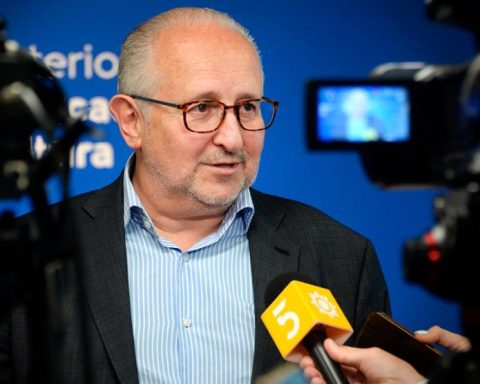Half of the life of Marcelo Monteblanco passes with changes of whereabouts on both sides of the Atlantic. He was born in Uruguay, when the 21st century began he moved to Spain, returned to Uruguay, returned to Spain and again to Uruguay. And each one of those adventures she planned as if it were the last time. But not. No one but him can cling to that old philosophical concept that life is like a journey, that which happens while we move.
Now —after two decades of riding between Montevideo and Barcelona— he finally reached a conclusion: “Uruguay is Peñarol and Spain is Barcelona FC.: in Spain everything happens faster, it’s more orderly and of a higher category… but in the end you don’t vibrate. When they are upset with a referee’s decision, the fans take out a white handkerchief and shout: ‘I referred, you are bad.’ Here, in Uruguay, everything is slowerit is played badly, the opportunities are fewer, but blood runs through the veinsthe choripán is insane and delicious at the same time, the children laugh and cry… it vibrates”.
Marcelo Monteblanco —42 years old, dual nationality and two children born in Barcelona who now live in Uruguay like him— is vivid proof of the migratory flows that unite Spain and Uruguay. Because there was an exodus after the 2002 crisis, a return from 2009 to 2017, a new exodus in the economic slowdown prior to the pandemic, a plateau during the health emergency and a new uptick in emigration after the reopening of borders.
“Since the beginning of the 21st century Spain has become the main recipient country of emigration flows of the Uruguayan population”, says demographer Martín Koolhaas, from the Population Program of the University of the Republic. In an investigation that summarizes a chapter of his doctoral thesis, and which he published this week in the open documents repository of Udelar, he shows with evidence how the number of people born in Uruguay who live in the Iberian country grew, to the point of exceeding 83,000 people this year. In other words: in Spain today there are more people born in Uruguay than in departments such as Artigas, Cerro Largo, Durazno, Flores, Florida, Lavalleja, Río Negro, Rocha, Soriano, or Treinta y Tres.
Uruguay is a country that expels its population: Since the 1950s, when “getting off the boats” ceased, leaving “became a structural phenomenon of Uruguayan society,” says Koolhaas. Argentina, due to its proximity and similarity, was the favorite place as a destination. And after the 2002 crisis —in which the neighboring country was also mired in crisis and the president at the time resigned by helicopter— Spain was the one that began to capture the largest flight of Uruguayans (sometimes more than 10,000 per year).
Monteblanco was not expelled by the crisis, at least not the economic one. He was 20 years old, he was late in high school “without being clear about what he wanted to be” and he worked with an uncle until an argument separated them. It was then that chance won him over: an old friend from his high school had gone to live in Barcelona and tempted him. Why not go? With the money that he gathered after his uncle’s dismissal from the company, he got on a plane, evaded the Spanish immigration post despite not having Spanish documentation (the then president José María Aznar had not reformed the Immigration Law that expedited the expulsion of immigrants) and began the first of their migratory adventures.
In Barcelona —where Marcelo was a waiter, a Mexican food cook, where he had his children, where he saw the trident Messi-Neymar-Suárez— More people born in Uruguay live than the sum of all the inhabitants of Ciudad Vieja or Barrio Sur. It is the favorite city of the Uruguayan emigration to which, if Girona and Tarragona are added, make Catalonia “the most charrúa autonomous community”.
After the financial crisis of 2002, and always leaving Catalonia aside, Tenerife and Valencia were the other towns with the highest growth of the Uruguayan population. Therefore, it can be said that “there is an evident preference of the Uruguayan population for residing in coastal urban areas,” explains Koolhaas. In fact, in Madrid, the Spanish capital, there are fewer people born in Uruguay than in the Balearic Islands or Galicia.
“The truth is that I did not plan to return to Uruguay. In Spain I was calm, my then wife (and mother of the children) had a good job as an architect, but the family weighed in when deciding to return”, admits Marcelo. Some relatives in Uruguay had had some “health mishaps”, the children visiting Montevideo became very close friends with their Uruguayan cousins, the final of the Libertadores to which Peñarol arrived showed him that “from a distance you suffer twice as much” and that is why in 2012 he returned to Uruguay.
Between 2009 and 2015, more people born in Uruguay were removed from the Spanish registry than those who entered the system. It coincides with a return process that, according to Koolhaas, was motivated by at least two phenomena: the crisis in Europe at the time of the “tailwind” in South America, and the law that allowed returnees tax exemption.
“Without that law, I wouldn’t have come back. Because as I had certain doubts, I brought the car that I had bought in Spain and for that I needed the tax exemption”, says Monteblanco.
At that return stage, demographer Koolhaas found that there was a return of more men than women. Why? “Most of the people who decide to leave Spain do so at an economically active age and in the context of the deterioration of Spanish employment, it should be considered that men in general terms have been more affected by the crisis (many worked in construction)”.
In Uruguay Monteblanco and his family had a good experience: once again good work, their children adapted well to school… but in 2016 doubts returned. “My wife was in a job that asked her to do everything at the same time, very Uruguayan, I had studied computer science and was willing to continue studying in Barcelona, so we left again. We sold everything and got on the plane knowing that we had all the documents because we were already Spanish. I clarify that we left with the intention of never returning, except to visit.
But that return to Spain was not what he imagined. “We noticed the children dull, sad. They were always active gurises, and the first months in Barcelona were unrecognizable. We went to see Suárez at the Barcelona stadium and my son asked me to leave at halftime. I told him that a few meters away he had all the players of the play (the Playstation), but he preferred the churros from the Centenario Stadium”, he comments between laughs.
So the good jobs or his entry into the computer team of one of the most important banks in Catalonia did not matter. As the saying goes: there are no two without three. They turned around again.
And here it is, in Uruguay, in a country that is only separated by the Atlantic Ocean from its other home. Like thousands of Uruguayans.

















